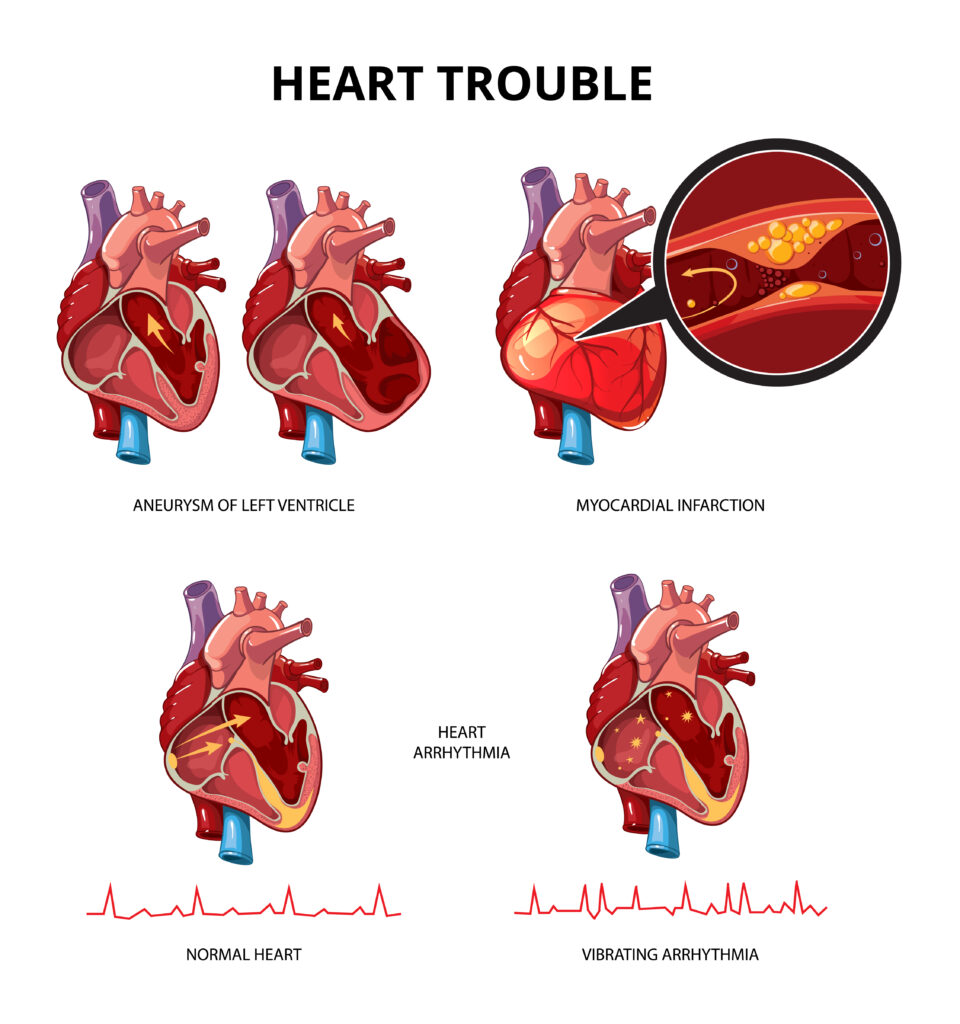Table of Contents
Introduction-What is Myocardial Infarction and Type of Myocardial Infarction?
The cause of myocardial infarction is a sudden interruption in blood flow to the heart muscle. As a result, it is a serious, life-threatening condition. This blockage is usually caused by the formation of blood clots or fatty deposits (atherosclerosis) in one of the arteries that supply more oxygenated blood to the heart.
When there is blood flow to the affected area of the heart, the heart muscle is deprived of oxygen and nutrients, causing tissue damage or death. The severity of the heart attack depends on the degree of occlusion in the arteries and the speed of treatment.
The most common symptoms of a heart attack include severe chest pain or discomfort that may radiate to the left arm, neck, jaw, or back.
Other symptoms include shortness of breath, sweating, nausea, and dizziness.
Rapid recognition and prompt treatment are essential for the treatment of myocardial infarction. Treatment may include drugs that prevent blood from clotting, or surgery, such as angioplasty, which inserts a stent to open the blocked artery and restore blood flow. Lifestyle changes such as adopting a healthy heart, exercising regularly, and quitting smoking are important to prevent further complications and reduce the risk of future heart attacks.
Type of Myocardial Infarction?
A myocardial infarction, commonly known as a heart attack, occurs when blood flows to part of the heart muscle, causing damage or death to the heart muscle. There are many types of myocardial infarction, which can be divided into several factors, including the location of the occlusion and the specific characteristics of the heart attack.

Some types of Myocardial Infarction include:
STEMI (ST-segment elevation myocardial infarction): This type of heart attack is characterized by complete occlusion of the arteries, usually leading to ST-segment elevation on an electrocardiogram (ECG). He needs urgent treatment.
NSTEMI (non-ST segment ascending myocardial infarction): In this type, the coronary arteries are partial and cause incomplete ST elevation on the ECG. While it’s still a serious condition, it may not have the immediate effects that a STEMI does.
Silent Myocardial Infarction: Sometimes a heart attack does not cause any symptoms. This is called a silent myocardial infarction and can be detected later by a medical exam or examination.
It is important to consult a doctor to obtain facts and personal information about your condition. If you or someone you know has symptoms of a heart attack, call the emergency services or go to the nearest hospital for emergency treatment.
What is the most common Type of Myocardial Infarction (MI)?
There are two main types of Myocardial Infarction (MI), commonly known as Heart Attacks:
ST Elevation Myocardial Infarction (STEMI): STEMI is a serious type of heart attack caused by a complete blockage of an artery. This blockage deprives part of the heart muscle of oxygen, causing damage. STEMI is considered more serious and requires immediate medical attention.

Non-ST-elevation myocardial infarction (NSTEMI): NSTEMI is a mild heart attack caused by part of the coronary artery. Although not as serious as STEMI, it still needs to be evaluated and treated promptly.
The prevalence of STEMI and NSTEMI may vary in different cultures and regions. Sometimes the presentation of a heart attack may be atypical or mild, making it difficult to distinguish STEMI from NSTEMI. Doctors use electrocardiograms (ECG), blood tests, and other tests to distinguish between different types of myocardial infarction and determine appropriate treatment. It is important to remember that medical information is constantly changing, so new information may have been provided since my last update.
How to Prevent Myocardial Infarction (MI)?
Preventing myocardial infarction (MI), commonly known as a heart attack, requires good health and risk management. Here are some important steps you can take to reduce your risk of heart disease:
Quit Smoking: Smoking is a major risk factor for heart disease, including heart attack. If you smoke, get support to quit smoking as it will benefit your heart health.
Eat a Healthy Diet: Eat a nutritious diet that includes fruits, vegetables, protein-rich grains, and low-fat dairy products. Limit your intake of saturated and trans fats, cholesterol, sodium, and added sugar.
Exercise regularly: Do regular physical activities such as brisk walking, jogging, swimming, or cycling. Aim for at least 150 minutes of moderate exercise or 75 minutes of vigorous activity per week.
Control your weight: If you are overweight or obese, losing weight can reduce your risk of heart attack. A healthy diet and regular exercise are essential to achieving and maintaining healthy body weight.
Control Blood Pressure: high blood pressure is an important risk factor for myocardial infarction.
Monitor your blood pressure regularly, and if it rises, work with your doctor to get it under control with lifestyle changes and medication if needed.
Control Cholesterol: Levels of LDL cholesterol (“bad” cholesterol) can increase the risk of heart attack by causing plaques in the arteries. Maintain healthy cholesterol levels through diet, exercise, and medications prescribed by your doctor.
Diabetes Control: If you have diabetes, it is important to keep your blood sugar under control. Uncontrolled diabetes can lead to heart disease, including myocardial infarction.
Avoid drinking alcohol: Drinking too much alcohol can increase blood pressure and cause other heart problems. If you drink alcohol, do it in moderation (no more than one drink per day for women and no more than two drinks per day for men).
Stress Management: Chronic stress can affect your heart health. Practice stress reduction techniques such as meditation, deep breathing, yoga, or doing activities you love.
Periodic Health Checkups: Regular visits to your doctor for checkups and evaluations.
In this way, early diagnosis and control can be possible.
Medication Complication: If your doctor has given you medication for conditions such as high blood pressure or high cholesterol, take it as needed, and do not stop or adjust your medication without consulting your doctor.
Know the warning signs: Learn about heart symptoms such as chest pain, shortness of breath, arm or shoulder pain, nausea, and dizziness. If you are facing these kinds of symptoms, take medical attention immediately.
Remember that preventing a heart attack is a commitment to a healthy life. By following these tips and working closely with your healthcare team, you can reduce your risk of heart attack and improve your overall heart health.
Summary
Myocardial infarction (heart attack) occurs when a coronary artery is blocked, cutting off blood flow to part of the heart. There can be two types: STEMI (total blockade) and NSTEMI (partial blockade). Symptoms include chest pain, shortness of breath, and nausea. Prompt treatment is critical to minimizing damage and improving outcomes. Treatments include blood flow control, lifestyle changes, medications, and heart therapy. Regular follow-up is important for long-term heart health. I think we have explained well about Type of Myocardial Infarction and its prevention and Treatment.


[…] What Causes of Heart Attack? […]